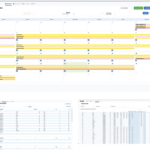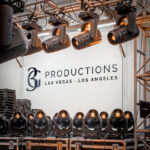The road to corporate success is littered with the ghosts of companies who have spun out in the ditch or otherwise failed to navigate the twists and turns along the way. Life on the corporate streets can be rough. But every once in a great while, a company comes along and defies the odds of survival. J.R. Clancy, the manufacturer of stage rigging systems based in Syracuse, N.Y., has not only survived for 125 years but has thrived in the theatrical rigging market. The company officially began in 1885 when a stagehand named John Clancy started designing and building stage-related equipment three years prior. Today, they design and manufacture automated rigging and controls, manual rigging systems, accessories, fire safety curtains, acoustic shells and canopies and a plethora of theatrical rigging hardware. They also design custom rigging systems for every application from the conventional to the unconventional.
J.R. Clancy is housed in a 40,000 square-foot facility where all of their products are manufactured. Most of it is dedicated to warehouse space, manufacturing and fabrication, research and development, while the front offices take care of sales, project management and administration. The building's signature smoke stack belies the purpose of the facility and in fact is used as a 60-foot high circular fly loft to test new products. It's a fitting statement about the company's nimble ability to adapt to the changing times and to find new uses for old technologies. How has the company managed to remain vital after 125 years in business?
The Corporate Culture
Spend just five minutes with virtually any employee of the company and you begin to get a sense of what the corporate culture is all about. They are quick to recite their mission statement, "Make Our Partners Successful," and to describe what they call their "extraordinary guarantee." Ship it on time, they say and make it complete and correct.
Chairman Bob Theis explains the philosophy behind the guarantee. "If you're going to take a hit, take it early," he says, meaning that it's better to correct any problems than to allow them to fester in the mind of the customer. "If we miss a ship date," said Tom Young, VP of marketing, "we'll pay for the lost time."
It sounds as if it could add up to considerable expense, but the reality is that they seldom fail to meet their promises. They are intensely focused on their commitment to the customer, as evidenced by their ISO 9001:2008 certification.
A few years ago, they invested a huge amount of time and effort to put into place procedures and documentation for a quality management system. They hired a consultant who is knowledgeable in the ISO standard to study their manufacturing process and look for ways to increase their efficiency. Theis called her a "shop floor psychologist." The consultant focused on teaching the company to improve upon what he called the five S's – sort, straighten, shine, standardize and sustain. In the end, they were better able to handle their larger orders such as PowerLift systems by making smaller shipments and having smaller build lots. The resulting gains in efficiency allow them to reinforce their commitment to customer satisfaction.
In addition to the physical layout of the manufacturing process, J.R. Clancy implemented a campaign to raise the awareness of quality throughout the company. They documented the procedures for maintaining quality standards and implemented internal audits, a Corrective Action System and a series of systems for collecting feedback from both employees and customer including surveys, comment cards, "Partner visits" and more.
To close the loop, they hold company-wide meetings quarterly to review the results of their efforts. If they average 9.5 out of 10 on all the returned surveys in a quarter, then all of the employees receive a bonus.
Does it make a difference? You bet.
"This place goes nuts when we get a customer complaint," says Mike Murphy, J.R. Clancy's president.
The incentives help pull employees together to work as a team. When one part of the equation slips, they all suffer; when they succeed, they all benefit.
The company philosophy, Young said, is to "take care of the customers and take care of the employees." It seems to work – of the roughly 50 employees that work for J.R. Clancy, several have been working there for more than 20 years.
The Technology
J.R. Clancy began manufacturing theatrical hardware when Thomas Edison was just starting to build DC generator systems and George Westinghouse was just starting to build AC generator systems. It was still undecided whose system would dominate, and the advent of the electronics industry was still far off. But J.R. Clancy has changed with the times, and today, much of their sales come from automation and control of rigging systems.
The PowerLift motorized winch system, for example, is built around an aluminum backbone with steel mounting clips. It has a series of headblocks with self-lubricating Nylatron sheaves, a motor, gearbox, and one of the two brakes integrated in a single unit and a redundant failsafe electric brake that monitors the speed of the drum to ensure it never exceeds the command speed or the maximum allowable speed. The system is built with an emphasis on safety and quietness, and there are five variable speed models plus a fixed speed model with a variety of speed ranges and load capacities.
Their top of the line automated rigging controller is the SceneControl 500. It is a PLC-based system with a touch screen display, a joystick, load monitors and deadman push buttons for added safety. The interface also has a 3-dimensional visualization of the rigging system and stage area, which aids in programming and control and makes it easy to use. There is even an offline editor for programming when the stage in inaccessible. The system can run an unlimited number of motors and its dual playbacks allow you to run two independent scenes at once. When the system is installed and every time a load on a set is changed, the controller "learns" the load profile by running it up and down one time. If there is a mishap, such as when a batten catches on an obstruction or lands on a set piece, the controller senses it through the load monitors and stops immediately.
The company is intensely focused on safety, as evidenced by the multiple layers of safety features including password protection, deadman operation, emergency stop button and more. They also offer an extended three-year warranty on their automated rigging systems provided the system is inspected annually. Dealers who participate in training are allowed to perform these inspections as part of their ongoing efforts to insure the safety of their systems.
Exciting Time
It's an exciting time to be in the rigging business, Young says. Not surprisingly, the growth rate of automated rigging is brisk. The flyman's job is rapidly changing from tossing pig iron to spotting or operating automated rigging systems. Stagehands are moving from manual labor positions to more highly-skilled positions when they learn how to program and run the controller.
From the venue's point of view, converting to automated rigging speeds load-ins and load-outs and significantly increases the safety factor. Even though an automated rigging system costs more than a counterweight rigging system, the safety factor can't be ignored. In the Netherlands, counterweight rigging systems have been banned, and others may follow. J.R. Clancy is poised to meet the demands of the market.
A few days after touring the factory, a book arrives in the mail from Bob Theis. It's titled On Becoming a Category of One: How Extraordinary Companies Transcend Commodity and Defy Comparison, by Joe Calloway. By reading it, one can clearly see where Theis gets many of his ideas.
"Extraordinary companies (have) a clear sense of who they are," Calloway writes. "They all define themselves, not in terms of what they sell, but in terms of what the point is for their employees, stakeholders and customers. The drive to serve, accomplish and achieve is much more powerful than the drive to simply make more money or to sell more widgets."
The company has been through only four owners in 125 years, including J.R. Clancy, Ben Tomkins, George Scherrer, Jr. and Bob Theis. Remarkably, the words of the original owner and company namesake echo the sentiments of Calloway in one of the earliest company catalogs published in 1903.
"Our object is to please every customer (large or small) every time…Yours very respectfully, J.R. Clancy."


